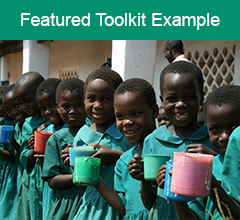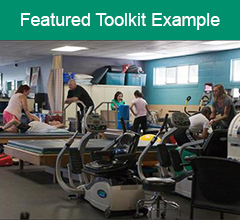This toolkit supports planning for using different tactics to sustain your organization or community initiative.
- Decide whether the organization or effort needs to be sustained and for how long:
- Estimate how long the organization or effort should be in place to accomplish its goals (e.g., 1 year, 10 years).
- Specify whether the organization or effort should end (e.g., a one-time event) or has goals that require it be ongoing.
- Assess whether there is sufficient support in the community to maintain the initiative (or likely will be).
- If the responses indicate that the effort can or should be in place for a substantial time, develop a plan for sustainability.
Related resources:
Strategies for the Long-Term Institutionalization of an Initiative: An Overview
- Clarify the goals and context for sustaining the effort.
- What aspects of the effort need to be sustained to achieve the initiative’s goals
- Whether the goals for the effort are open to expansion or change
- What the group has accomplished in terms of reaching its goals
- Current structure and organization of the initiative
- Needed resources to support permanent personnel
- Current foundation or basis of funding and resources (e.g., money or other support)
- Potential obstacles to sustainability
- Public’s awareness of the group or effort
Related resources:
Creating Objectives
Developing a Management Plan
- Create a business plan to anticipate what resources will be necessary to sustain the organization or effort.
- Describe the services or products (activities) to be offered, including:
- Specify the services or products you provide (e.g., training, advocacy, specific needed services and supports). What will your organization or effort offer?
- Need for the service or product. What benefits will result? What is the value added beyond what is already available?
- Competition. Who is positioned to offer the same or similar service or product? Why is yours better?
- Qualifications and reputation of the organization providing the service or product. What is your organization's experience and history of success? What is its reputation in the community?
- Describe the potential market or audience and how they will be reached:
- Audience or market for the service or product. Who can benefit? Who can pay?
- Promotion. How will they be reached (e.g., personal contacts, mailings, radio and/or TV)?
- Quality control. How will the quality and satisfaction with the service or product be assessed? How will feedback be obtained and used to continuously improve the service or product?
- Generate an annual budget, including:
- All projected expenses (e.g., salaries, office expenses, rent, utilities, phone and computer expenses, equipment, travel, etc).
- All projected income - based on current sources of funding and other in-kind resources.
- Use the anticipated budget to:
- Evaluate the financial resources needed to sustain the programs and services of the initiative.
- Identify ways to generate resources other than money (e.g., time, materials) to meet some of the anticipated expenses.
- Set priorities for which programs and services to maintain (e.g., those most important and/or cost effective).
- Set specific goals for financial resources to be generated for the organization or effort (e.g., how much of what kind of resources by when, e.g., “By 20XX, to have an annual operating budget of $200,000 with cash reserves equal to 25% of the budget”). What is the organization’s immediate financial goal? Longer-term goals?
Related resources:
Developing a Plan for Financial Sustainability
Creating a Business Plan
Planning and Writing an Annual Budget
- Describe the services or products (activities) to be offered, including:
- Identify specific tactics to be used to sustain the effort. Indicate how you will use potential tactics for financial sustainability, including:
- Share positions and resources – share staff positions, space, equipment, or other resources with organizations with similar goals.
- Become a line item in an existing budget of another organization – convince another organization to pick up part of the expenses of running the initiative (e.g., the city provides funding for a school health program).
- Incorporate the initiative’s activities or services into another organization with a similar mission.
- Apply for grants – consider time and resources that will be necessary for success, and the need for reapplication.
- Tap into available personnel resources – recruit people or positions in other organizations that can be shared at low or no cost (e.g., clerical staff, volunteers).
- Solicit in-kind support – seek goods and services the organization would otherwise have to purchase (e.g., donations of office supplies from a local business).
- Develop and implement a fundraiser – identify and offer products, services or events that will inspire others to contribute money to the organization.
- Pursue third party funding – solicit third parties not actually involved with the effort, and not directly benefiting from it, to provide resources for services (e.g., insurance companies support valued services).
- Develop a fee-for-service structure – require clients who receive services to pay for them (e.g., sliding-fee scales based on clients’ ability to pay).
- Acquire public funding (e.g., from legislature or city council).
- Secure endowments or planned giving arrangements – use interest from funds as annual income.
- Establish a donor or membership base – donors or members help provide unrestricted funds to support the operations of the organization (e.g., dues, gifts).
Related resources:
Strategies for Sustaining the Initiative
- Develop a marketing plan to secure resources for the organization or effort. Indicate how you will use the “4Ps” of marketing in implementing your plan, including:
- Product (e.g., what your group offers, and its benefits)
- Price (e.g., costs, value added)
- Place (e.g., how you will make it easier for people to contribute)
- Promotion (e.g., what message will be carried to whom, by whom, through what means)
Related resources:
Conducting a Social Marketing Campaign
- Outline a specific action plan for sustaining the organization or effort. For each sustainability tactic you will use (e.g., obtain grant funding), develop a specific action plan, including:
- What activities will be carried out
- Who will do it
- By when the activity will be completed, or for how long it will be maintained
- Resources that will be needed to complete it
- Communication – who should know what about this
Related resources:
Developing Successful Strategies: Planning to Win
Developing an Action Plan







